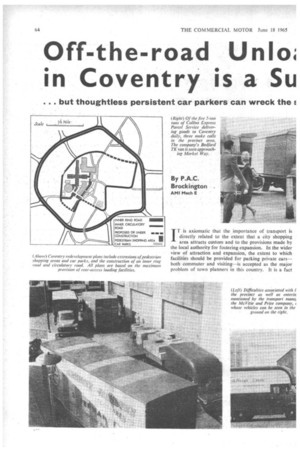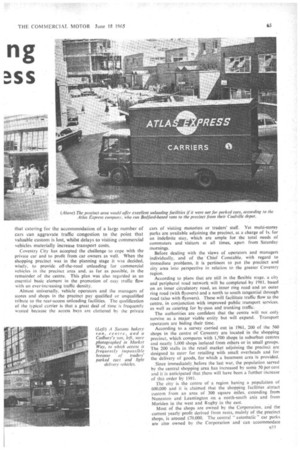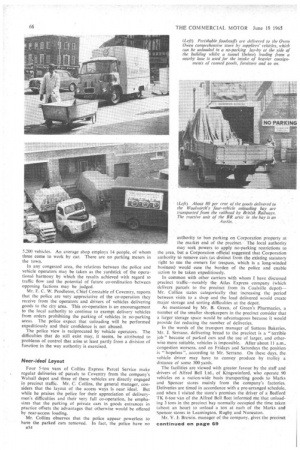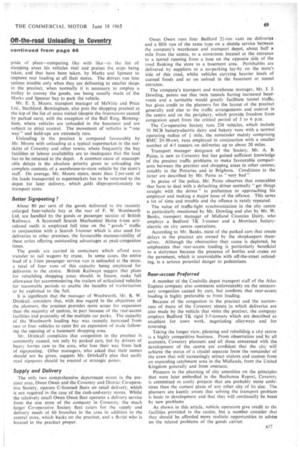Off-the-road Unlo in Coventry is a Su
Page 66

Page 67

Page 68

Page 71

If you've noticed an error in this article please click here to report it so we can fix it.
• but thoughtless persistent car parkers can wreck the 1
By P.A.C. Brockington
AMI Mech E
IT is axiomatic that the importance of transport is directly related to the extent that a city shopping area attracts custom and to the provisions made by the local authority for fostering expansion. In the wider view of attraction and expansion, the extent to which facilities should be provided for parking private cars— both commuter and visiting—is accepted as the major problem of town planners in this country. It is a fact
that catering for the accommodation of a large number of cars can aggravate traffic congestion to the point that valuable custom is lost, whilst delays to visiting commercial vehicles materially increase transport costs.
Coventry City has accepted the challenge to cope with the private car and to profit from car owners as well. When the shopping precinct was in the planning stage it was decided, wisely, to provide off-the-road unloading for commercial vehicles in the precinct area and, as far as possible, in the remainder of the centre. This plan was also regarded as an essential basic element in the promotion of easy traffic flow with an ever-increasing traffic density.
Almost universally, vehicle operators and the managers of stores and shops in the precinct pay qualified or unqualified tribute to the rear-access unloading facilities. The qualification of the typical carrier is that a great deal of time is frequently wasted because the access bays are cluttered by the private cars of visiting motorists or traders' staff. Yet multi-storey parks are available adjoining the precinct, at a charge of is. for an indefinite stay, which are ample for the total needs of commuters and visitors at all times, apart from Saturday mornings.
Before dealing with the views of operators and managers individually, and of the • Chief Constable. with regard to immediate problems, it is pertinent to put the precinct and city area into perspective in relation to the greater Coventry region.
According to plans that are still in the flexible stage. a city and peripheral road network, will be completed by 1981, based on an inner circulatory road, an inner ring road and an outer ring road (with flyovers) and a north to south tangential through road (also with flyovers). These will facilitate traffic flow to the centre, in conjunction with improved public transport services. as well as catering for by-pass and trunking traffic.
The authorities are confident that the centre will not only survive as a major viable 'entity but will expand. Transport operators arc biding their time. According to a survey carried out in 1961, 200 of the 560 shops in the centre of Coventry are located in the shopping precinct, which compares With 1,500 shops in suburban centres and nearly 1.000 shops isolated from others or in small groups. The 200 stalls in the retail market adjoining the precinct are designed to cater for retailing with small overheads and for the delivery of goods, for which a basement area is provided.
.Since immediately, before the last war, the population served by the central shopping area has increased by some 50 Per cent and it is anticipated that there will have been a further increase of this order by 1981. The city is the centre of a region having a population of 600.000 and it is claimed that the shopping facilities attract custom from an area of 300 square miles, extending from Nuneaton and Leamington on a north-south axis and from Meriden in the west and Rugby in the east.
Most of the shops are owned by the Corporation. and the current yearly profit derived from rents, mainly of the precinct shops. is around f70,000. The central " autornatic " car parks are also owned by the Corporation and can accommodate 5,200 vehicles. An average shop employs 14 people, of whom three come to work by car. There are no parking meters in the town.
In any congested area, the relations between the police and vehicle operators may be taken as the yardstick of the operational harmony by which the results achieved with regard to traffic flow and the potential of future co-ordination between opposing factions may be judged.
Mr. E. C. W. Pendleton, Chief Constable of Coventry. reports that the police are very appreciative of the co-operation they receive from the operators and drivers of vehicles delivering goods to the city area. This co-operation is an encouragement to the local authority to continue to exempt delivery vehicles from orders prohibiting the parking of vehicles in no-parking areas. The police expect that unloading will be performed expeditiously and their confidence is not abused.
The police view is reciprocated by vehicle operators. The difficulties that do still exist may, it seems, be attributed to problems of control that arise at least partly from a division of function in the way authority is exercised.
Near-ideal Layout Four 5-ton vans of Collins Express Parcel Service make regular deliveries of parcels to Coventry from the company's Walsall depot and three of these vehicles are directly engaged in precinct traffic. Mr. C. Collins, the general manager, considers that the layout of the access ways is near ideal. But while he praises the police for their appreciation of deliverymen's difficulties and their very full co-operation, he emphasizes that the parking of private cars in goods entrances in practice offsets the advantages that otherwise would be offered by rear-access loading.
Mr. Collins observes that the police appear powerless to have the parked cars removed. In fact, the police have no n14 authority to ban parking on Corporation property at the market end of the precinct. The local authority may seek powers to apply no-parking restrictions to the area, but a Corporation official suggested that Corporation authority to remove cars (as distinct from the existing statutory right to sue the owners for trespass, which is a long-winded business) would ease the burden of the police and enable action to be taken expeditiously.
In common with other carriers with whom I have discussed precinct traffic—notably the Atlas Express company (which delivers parcels to the precinct from its Coalville depot)— Mr. Collins states categorically that increasing the period between visits to a shop and the load delivered would create major storage and sorting difficulties at the depot.
As mentioned by Mr. B. Green. of Green's Pharmacies, a number of the smaller shopkeepers in the precinct consider that a larger storage space would be advantageous because it would provide for reducing the number of deliveries.
In the words of the transport manager of Suttons Bakeries, Mr. J. Serrano. delivering bread to the precinct is a " terrible job" because of parked cars and the use of larger, and otherwise more suitable, vehicles is impossible. After about 11 a.m., congestion worsens, and on Fridays and Saturdays the position is "hopeless ", according to Mr. Serrano. On these days. the vehicle driver may have to convey produce by trolley a distance of some 300 yards.
The facilities are viewed with greater favour by the staff and drivers of Alfred Bell Ltd.. of Kingswinford, who operate 90 vehicles on a nation-wide basis transporting goods to Marks and Spencer stores mainly from the company's factories. Deliveries are timed in accordance with a pre-arranged schedule, and when I visited the store's premises the driver of a Bedford TK 6-ton-van of the Alfred Bell fleet informed me that unloading 3 tons in the precinct bay normally occupied the time taken (about an hour) to unload a ton at each of the Marks and Spencer stores in Leamington. Rugby and Nuneaton.
Mr. V. J. grovin, manager of the company, gives the precinct continued on page 69 pride of place—comparing like with like—in the list of shopping areas his vehicles visit and praises the steps being taken, and that have been taken, by Marks and Spencer to improve rear loading at all their stores. The drivers run into serious trouble only when they are delivering to smaller shops in the precinct, when normally it is necessary to employ a trolley to convey the goods; use being usually made of the Marks and Spencer bay to park the vehicle.
Mr. E. S. Moore, transport manager of McVitie and Price Ltd., Stechford, Birmingham, also puts the shopping precinct at the top of the list of areas visited (despite the frustrations caused by parked cars), with the exception of the Bull Ring. Birmingham, where vehicles are 'unloaded in the basement and are subject to strict control. The movement of vehicles is "one way" and hold-ups are extremely rare.
Unloading in the precinct is compared favourably by Mr. Moore with unloading at a typical supermarket in the outskirts of Coventry and other towns. where frequently the bay facilities or labour availability are so inadequate that the load has to be returned to the depot. A common cause of unacceptable delays is the absolute priority given to unloading the complete contents of a warehouse-to-store vehicle by the store's staff: On average, Mr. Moore states, more than 2 per cent of the loads transported to supermarkets has to be returned to the depot for later delivery, which ;adds disproportionately to transport costs.
Better Signposting?
About 80 per cent of the goods delivered to the recently enlarged four-vehicle bay at the rear of F. W. Woolworth Ltd. are handled by the goods or passenger section of British Railways. A Scammeil Scarab Mechanical Horse 6-ton articulated outfit is employed full time on the "goods" traffic in conjunction with a Scarab 3-tonner which is also used for deliveries to other premises, the favourable maneeuvrability of these artics offering outstanding advantages at peak-congestion times.
The goods are carried in containers which afford easy transfer to rail wagons by crane. In some cases, the entire load of a 3-ton passenger service van is unloaded at the store, a total of four vans of this capacity being employed for deliveries to the centre. British Railways' suggest that plans for rebuilding shopping areas should, in future, make full allowance for accommodating the trailers of articulated vehicles for reasonable periods to enable the benefits of trailerization to be exploited to the full.
It is significant that the manager of Woolworth, Mr. R. W. Drinkall. considers that, with due regard to the objectives of the planners, the precinct provides more scope for expansion than the majority of centres, in part because of the rear-access facilities and proximity of the multiple car parks. The capacity of the Woolworth loading bay was recently increased from two to four vehicles to cater for an expansion of trade following the opening of a basement shopping area.
Mr. Drinkall complains that congestion in the precinct is commonly caused, not only by parked cars, but by drivers of heavy lorries new to the area, who lose their way from lack of signposting. Other managers, who asked that their names should not be 'given, support Mr. Drinkall's plea that easily read signposts should be erected at strategic points.
Supply and Delivery The only two comprehensive department stores in the precinct area, Owen Owen and the Coventry and District Co-operative Society, operate C-licensed fleets on retail delivery, which is not required in the case of the cash-and-carry stores. Whilst the relatively small Owen Owen fleet operates a delivery service from the one store of the company in Coventry. the much larger Co-operative Society fleet caters for the supply and delivery needs of 60 branches in the area in addition to the central store, which backs on the precinct, and a florist who is located in the precinct proper. Owen Owen runs four Bedford 24-ton vans on deliveries and a fifth van of the same type on a shuttle service between the company's warehouse and transport depot, about half a mile from the centre, to a storeroom located at the entrance to a tunnel running from a lane on the opposite side of the road flanking the store to a basement area. Perishables are delivered by suppliers to a no-parking lay-by on the store's side of this road, whilst vehicles carrying heavier loads of canned foods and so on unload in the basement or tunnel entrance.
The company's transport and warehouse manager, Mr. J. J. Dowling, points out that twin tunnels having increased headroom and a turntable would greatly facilitate tunnel traffic, but gives credit to the planners for the layout of the precinct generally and also to the traffic arrangements and control in the centre and on the periphery, which provide freedom from congestion apart from the critical period of 5 to 6 p.m.
The Co-operative Society runs 230 vehicles, which include 50 NCB battery-electric dairy and bakery vans with a normal operating radius of mile, the remainder mainly comprising BMC 20-30-cwt. vans employed in conjunction with a smaller number of 4-5 tonners on deliveries up to about 20 miles.
Transport manager designate of the Society, Mr. A. B. Paine, is new to Coventry but has gained sufficient knowledge of the precinct traffic problems to make favourable comparisons between the precinct and shopping areas in other centres, notably in the Potteries and in Brighton. Conditions in the latter are described by Mr. Paine as "very bad ".
In praise of the police, Mr. Paine observes that constables that have to deal with a defaulting driver normally "get things straight with the driver" in preference to approaching his employer and making a major issue of the offence. This saves a lot of time and trouble and the offence is rarely repeated.
The value of traffic-light synchronization in the city centre is particularly mentioned by Mr. Dowling and also by Mr. W. Banks, transport manager of Midland Counties Dairy, who employs a Bedford TK 3-tonner and a Morrison batteryelectric on city centre operations.
According to Mr. Banks, most of the parked cars that create delays in the precinct are owned by the shopkeepers themselves. Although the obstruction they cause is deplored, he emphasizes that rear-access loading is particularly beneficial to a dairyman because the presence of bottles and crates on the pavement, which is unavoidable with off-the-street unloading, is a serious potential danger to pedestrians.
Rear-access Preferred A member of the Coalville depot transport staff of the Atlas Express company also comments unfavourably on the unnecessary congestion caused by cars, but confirms that rear-access loading is highly preferable to front loading.
Because of the congestion in the precinct and the narrowness of many of the Coventry streets in which deliveries are also made by the vehicle that visits the precinct, the company employs Bedford TK rigid 3-5-tormers which are described as excellent for town work, negotiating alleyways and for reversing.
Taking the longer view, planning and rebuilding a city centre is a highly competitive business.. From observation and by all accounts, Coventry planners and all those concerned with the. development of the centre are confident that the city will achieve the status of a citadel separate from the remainder of the town that will increasingly attract visitors and custom from an expanding catchment area in the Midlands, from the United Kingdom generally and from overseas.
Pioneers in the planning of city amenities on the principles that were later embodied in the Buchanan Report, Coventry is committed to costly projects that are probably more ambitious than the current plans of any other city of its size. The planners are keenly aware that solving the transport problem is basic to development and that they will continually be beset by new problems As shown in this article, vehicle operators give credit to the facilities provided in the centre, but a number consider that they should be afforded more realistic opportunities to advise on the related problems of the goods carrier.




































































































































